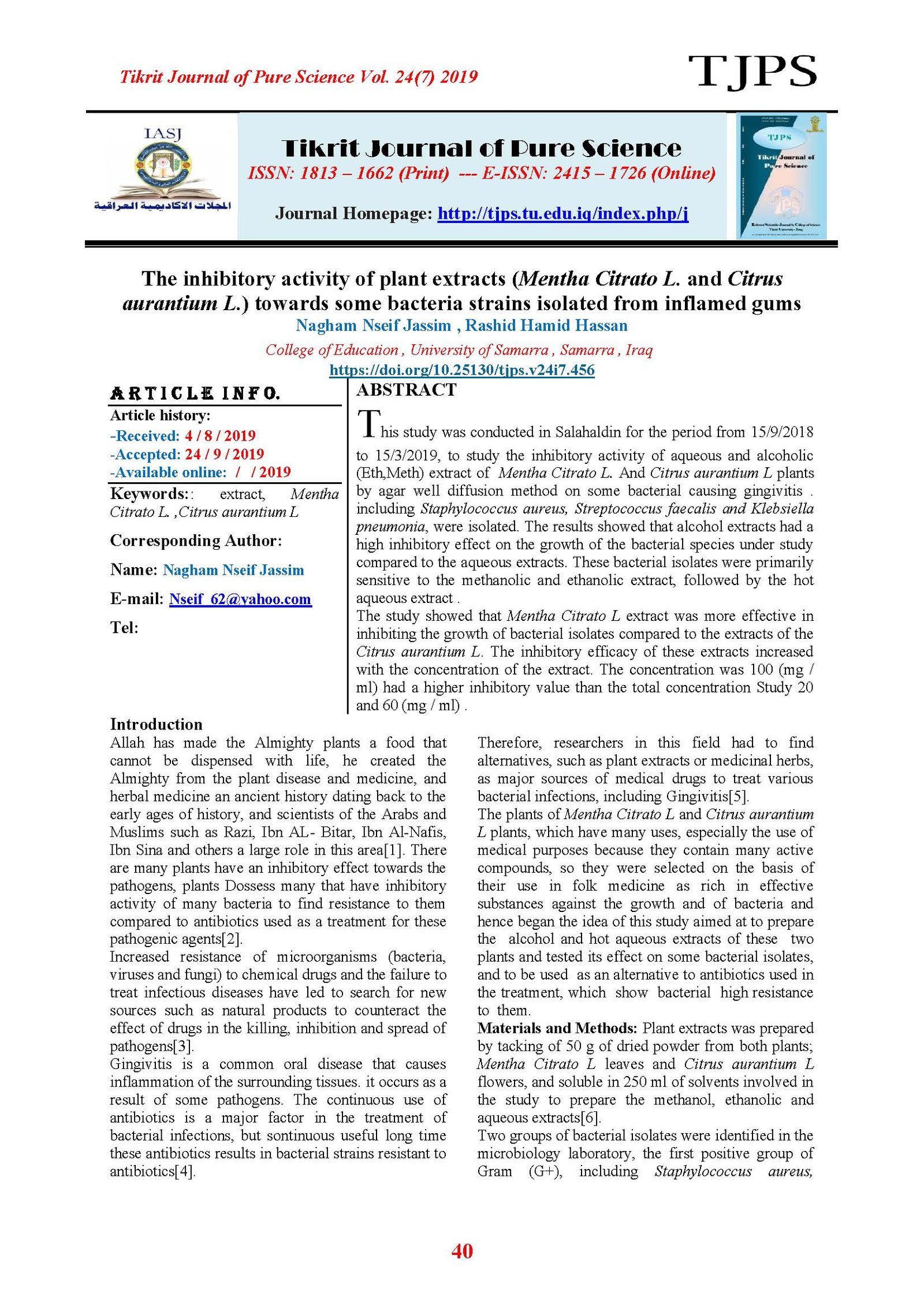The inhibitory activity of plant extracts (Mentha Citrato L. and Citrus aurantium L.) towards some bacteria strains isolated from inflamed gums
Main Article Content
Abstract
This study was conducted in Salahaldin for the period from 15/9/2018 to 15/3/2019, to study the inhibitory activity of aqueous and alcoholic (Eth,Meth) extract of Mentha Citrato L. And Citrus aurantium L plants by agar well diffusion method on some bacterial causing gingivitis . including Staphylococcus aureus, Streptococcus faecalis and Klebsiella pneumonia, were isolated. The results showed that alcohol extracts had a high inhibitory effect on the growth of the bacterial species under study compared to the aqueous extracts. These bacterial isolates were primarily sensitive to the methanolic and ethanolic extract, followed by the hot aqueous extract .
The study showed that Mentha Citrato L extract was more effective in inhibiting the growth of bacterial isolates compared to the extracts of the Citrus aurantium L. The inhibitory efficacy of these extracts increased with the concentration of the extract. The concentration was 100 (mg / ml) had a higher inhibitory value than the total concentration Study 20 and 60 (mg / ml) .
Article Details

This work is licensed under a Creative Commons Attribution 4.0 International License.
Tikrit Journal of Pure Science is licensed under the Creative Commons Attribution 4.0 International License, which allows users to copy, create extracts, abstracts, and new works from the article, alter and revise the article, and make commercial use of the article (including reuse and/or resale of the article by commercial entities), provided the user gives appropriate credit (with a link to the formal publication through the relevant DOI), provides a link to the license, indicates if changes were made, and the licensor is not represented as endorsing the use made of the work. The authors hold the copyright for their published work on the Tikrit J. Pure Sci. website, while Tikrit J. Pure Sci. is responsible for appreciate citation of their work, which is released under CC-BY-4.0, enabling the unrestricted use, distribution, and reproduction of an article in any medium, provided that the original work is properly cited.
References
[1] Al-Qahtani, J.B. (2007). Gaber Encyclopedia of Herbal Medicine. Part II, Al-Obeikat Library, second edition.
[2] Al-Thawaini, A.N.: Al-Mina'i, S.A and Ibrahim, A.H. (2008). Study of the pilot oil chemical extracted from basil leaves and evaluate its inhibitory effectiveness in some pathogenic microorganisms. Nahrain University Journal. Volume 11(2).
[3] Abad , M.J. ; Ansuategui , M. and Bermejo , P. (2007): Active antifungal substances from natural sources . Archivoc , pp. 116-145.
[4] Schulz, L., Hoffman, R., Pothof, J., Fox, B. (2016). Top Ten Myths Regarding the Diagnosis and Treatment of Urinary Tract Infections. The Journal of Emergency Medicine, 51(1) :25-30
[5] Yadav, R.S. and Kumar, S. (2006): Antifungal properties of essential oils of menthespicatel var. mss, Indian J. crop science, 9 (1) : 1970.
[6] Sule, I.O. and Agbabiaka, T.O. (2008): Antibacterial Effect of Some Plant Extract an selected Enterobacteriaceae, Ethnobotanical Leaflets. Vol. 12 : pp. 1035-1042.
[7] Oqaily, A,H. (2002). Study of the effect of acetic acid and some plant extracts in the growth of bacterial wound injuries. Master Thesis, Faculty of Science - Mustansiriya University.
[8] Zankana, Sh. A. (2004). Effect of Plant Extracts on Growth of Pathogenic Bacteria, Master Thesis, Faculty of Science, Anbar University.
[9] Al – Zuhair, H.A (2007) . Effect of cloves, tannins and icing extracts in the treatment of some bacteria and fungal infections. PhD thesis, Faculty of Science, Mustansiriya University.
[10] Dulaimi, Fatima, I.S. (2006). The inhibitory effect of extracts of some medicinal plants and the synergy between their active ingredients and antibiotics in S.aureus bacterium and Typhimurium Salmonella isolated from food poisoning, Master Thesis. Faculty of Education, University of Mosul.
[11] Al- Abdallah, A.H. (2016). Effect of Plant extracts on growth candidia albicans and staphylococcus aureus. Afrecan J. Pharmacy and Pharmacology , 10 (16) : 337-343.
[12] Zaid ,A.T (2018) .Evaluation of some bio active effect of phenolic compound in Costus speciosus rhizome exract. Iraqi Juornal of Scince, Vol, 59. No.1 ,pp:151-161.
[13] Tortora G. J., Funke, B. R., & Case, C. L. (2016). Microbiology: An Introdiction 13th ed. Pearson Education Inc., Benjamin Cummings, San 10th ed. Benjamin / Francisco.
[14] Singh , P. and Pandey, A. (2011). Antibacterial activity of syzgiumaromaticum (clove) with metal ion effect against food borne pathogens. Asian, J. plant science and Research ., 1(2) : 69-80.
[15] Thawaini, A.N; Star, S.N and Sabah H.M. (2010). Effect of water and alcohol extracts on clover and black bean plants and on the development of some pathogenic bacteria. University of Kufa Journal of Life Sciences, 2 (1): 1-12.
